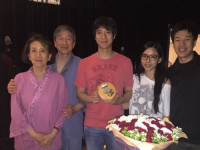iOS中的下拉刷新SVPullToRefresh
来源:互联网 发布:像趣头条软件 编辑:程序博客网 时间:2024/06/15 20:44
下拉刷新是一种利用手势刷新用户界面的功能,虽然已经被Twitter申请为专利,但依然不能阻止广大的App开发者在自己的应用中加入该功能。苹果公司甚至在iOS6的sdk中加入了UIRefreshControl,从而实现了系统级的下拉刷新。但是UIRefreshControl是绑定在UITableViewController上的,所以灵活性不高。
如果在网上搜下拉刷新的实现,讨论最多的恐怕是EGOTableViewPullRefresh了,这是一个比较有历史的开源库了,github上最近一次提交都是两年前的事情了。EGOTableViewPullRefresh虽然很好的实现了下拉刷新功能,但是一些OC的新特性比如arc、block没有得到支持,导致加个下拉刷新要写不少代码。
于是乎EGOTableViewPullRefresh的替代者出来了,就是SVPullToRefresh。支持arc,支持block,而且简洁到只需一行就能实现下拉刷新和上拉加载。
SVPullToRefresh的下拉刷新用法相当简单:
1、将下拉刷新控件放在顶部
[tableView addPullToRefreshWithActionHandler:^{ // prepend data to dataSource, insert cells at top of table view // call [tableView.pullToRefreshView stopAnimating] when done}];2、将下拉刷新控件放在底部
[tableView addPullToRefreshWithActionHandler:^{ // prepend data to dataSource, insert cells at top of table view // call [tableView.pullToRefreshView stopAnimating] when done} position:SVPullToRefreshPositionBottom];3、程序自动调用下拉刷新
[tableView triggerPullToRefresh];
4、临时性禁用下拉刷新
tableView.showsPullToRefresh = NO;SVPullToRefresh的UI支持自定义
下拉刷新对应的view名叫pullToRefreshView,有如下属性和方法修改它的显示。
@property (nonatomic, strong) UIColor *arrowColor;@property (nonatomic, strong) UIColor *textColor;@property (nonatomic, readwrite) UIActivityIndicatorViewStyle activityIndicatorViewStyle;- (void)setTitle:(NSString *)title forState:(SVPullToRefreshState)state;- (void)setSubtitle:(NSString *)subtitle forState:(SVPullToRefreshState)state;- (void)setCustomView:(UIView *)view forState:(SVPullToRefreshState)state;简单用法,比如下面一行代码就修改了下拉箭头的颜色。
tableView.pullToRefreshView.arrowColor = [UIColor whiteColor];
上面介绍了下拉刷新的基本用法,下拉加载的用法也差不多,就不再介绍了,可以参考官方资料https://github.com/samvermette/SVPullToRefresh
-------------------------------------------------------------------------------------------------------------------------------------------------------
下面探讨一下SVPullToRefresh背后的原理,SVPullToRefresh能把接口设计的如此简单,肯定有一些过人之处,我们以后在设计控件的时候或许也能从中得到一些启发。
SVPullToRefresh的库其实也就两个类,分别对应下拉刷新和上拉加载,因为两者原理差不多,所以只需要看下拉刷新的实现即可。
@interface UIScrollView (SVPullToRefresh)typedef NS_ENUM(NSUInteger, SVPullToRefreshPosition) { SVPullToRefreshPositionTop = 0, SVPullToRefreshPositionBottom,};- (void)addPullToRefreshWithActionHandler:(void (^)(void))actionHandler;- (void)addPullToRefreshWithActionHandler:(void (^)(void))actionHandler position:(SVPullToRefreshPosition)position;- (void)triggerPullToRefresh;@property (nonatomic, strong, readonly) SVPullToRefreshView *pullToRefreshView;@property (nonatomic, assign) BOOL showsPullToRefresh;@end@interface SVPullToRefreshView : UIView@property (nonatomic, strong) UIColor *arrowColor;@property (nonatomic, strong) UIColor *textColor;@property (nonatomic, strong, readonly) UILabel *titleLabel;@property (nonatomic, strong, readonly) UILabel *subtitleLabel;@property (nonatomic, strong, readwrite) UIColor *activityIndicatorViewColor NS_AVAILABLE_IOS(5_0);@property (nonatomic, readwrite) UIActivityIndicatorViewStyle activityIndicatorViewStyle;@property (nonatomic, readonly) SVPullToRefreshState state;@property (nonatomic, readonly) SVPullToRefreshPosition position;- (void)setTitle:(NSString *)title forState:(SVPullToRefreshState)state;- (void)setSubtitle:(NSString *)subtitle forState:(SVPullToRefreshState)state;- (void)setCustomView:(UIView *)view forState:(SVPullToRefreshState)state;- (void)startAnimating;- (void)stopAnimating;// deprecated; use setSubtitle:forState: instead@property (nonatomic, strong, readonly) UILabel *dateLabel DEPRECATED_ATTRIBUTE;@property (nonatomic, strong) NSDate *lastUpdatedDate DEPRECATED_ATTRIBUTE;@property (nonatomic, strong) NSDateFormatter *dateFormatter DEPRECATED_ATTRIBUTE;// deprecated; use [self.scrollView triggerPullToRefresh] instead- (void)triggerRefresh DEPRECATED_ATTRIBUTE;@end
SVPullToRefresh的实现用到了很多OC Runtime的特性。以前在用EGOTableViewPullRefresh时,我们需要
为当前的ViewController增加EGORefreshTableHeaderView的成员,还要实现相应protocol,这样ViewController就会显得臃肿。而SVPullToRefresh通过增加UIScrollView的Category,给需要下拉的scrollview增加了pullToRefreshView的属性,使用者不需要显式的创建它,与pullToRefreshView状态相关的逻辑也不用关心,只需要提供一个actionHandler来完成刷新结束后的一些操作。
但是category声明的property并不会自动@synthesize,所以需要手动实现getter和setter方法。通过runtime.h中objc_getAssociatedObject / objc_setAssociatedObject来访问和生成关联对象,从而模拟生成属性。如果要在不修改现有类的情况下增加属性,这是一个很好的办法。
- (void)setPullToRefreshView:(SVPullToRefreshView *)pullToRefreshView { [self willChangeValueForKey:@"SVPullToRefreshView"]; objc_setAssociatedObject(self, &UIScrollViewPullToRefreshView, pullToRefreshView, OBJC_ASSOCIATION_ASSIGN); [self didChangeValueForKey:@"SVPullToRefreshView"];}- (SVPullToRefreshView *)pullToRefreshView { return objc_getAssociatedObject(self, &UIScrollViewPullToRefreshView);}除了动态增加属性,SVPullToRefresh还用到了KVO来观察自身属性的变化从而进行相应的UI调整(用EGOTableViewPullRefresh的话这些代码都由调用方实现,如
UIScrollViewDelegate
)。UIScrollView在滑动时contentOffset,contentSize,frame都是需要监测的对象。
- (void)setShowsPullToRefresh:(BOOL)showsPullToRefresh { self.pullToRefreshView.hidden = !showsPullToRefresh; if(!showsPullToRefresh) { if (self.pullToRefreshView.isObserving) { [self removeObserver:self.pullToRefreshView forKeyPath:@"contentOffset"]; [self removeObserver:self.pullToRefreshView forKeyPath:@"contentSize"]; [self removeObserver:self.pullToRefreshView forKeyPath:@"frame"]; [self.pullToRefreshView resetScrollViewContentInset]; self.pullToRefreshView.isObserving = NO; } } else { if (!self.pullToRefreshView.isObserving) { [self addObserver:self.pullToRefreshView forKeyPath:@"contentOffset" options:NSKeyValueObservingOptionNew context:nil]; [self addObserver:self.pullToRefreshView forKeyPath:@"contentSize" options:NSKeyValueObservingOptionNew context:nil]; [self addObserver:self.pullToRefreshView forKeyPath:@"frame" options:NSKeyValueObservingOptionNew context:nil]; self.pullToRefreshView.isObserving = YES; CGFloat yOrigin = 0; switch (self.pullToRefreshView.position) { case SVPullToRefreshPositionTop: yOrigin = -SVPullToRefreshViewHeight; break; case SVPullToRefreshPositionBottom: yOrigin = self.contentSize.height; break; } self.pullToRefreshView.frame = CGRectMake(0, yOrigin, self.bounds.size.width, SVPullToRefreshViewHeight); } }}- (void)observeValueForKeyPath:(NSString *)keyPath ofObject:(id)object change:(NSDictionary *)change context:(void *)context { if([keyPath isEqualToString:@"contentOffset"]) [self scrollViewDidScroll:[[change valueForKey:NSKeyValueChangeNewKey] CGPointValue]]; else if([keyPath isEqualToString:@"contentSize"]) { [self layoutSubviews]; CGFloat yOrigin; switch (self.position) { case SVPullToRefreshPositionTop: yOrigin = -SVPullToRefreshViewHeight; break; case SVPullToRefreshPositionBottom: yOrigin = MAX(self.scrollView.contentSize.height, self.scrollView.bounds.size.height); break; } self.frame = CGRectMake(0, yOrigin, self.bounds.size.width, SVPullToRefreshViewHeight); } else if([keyPath isEqualToString:@"frame"]) [self layoutSubviews];}总结:SVPullToRefresh把所有的逻辑都由自身实现,对外只提供一个Block接口,方便调用者。原理上和EGOTableViewPullRefresh差不多,但通过Runtime特性和KVO的运用,把原来客户端实现的逻辑放到了自身来实现,最终呈现一个简单的接口。
- iOS中的下拉刷新SVPullToRefresh
- iOS中的下拉刷新SVPullToRefresh
- iOS中的下拉刷新SVPullToRefresh
- iOS中的下拉刷新SVPullToRefresh
- SVPullToRefresh 下拉刷新导航栏位置错误
- IOS常用第三方框架 --- SVPullToRefresh 下拉刷新、上拉加载更多
- 使用开源库 SVPullToRefresh 实现上拉加载下拉刷新
- 使用开源库 SVPullToRefresh 实现上拉加载下拉刷新
- SVPullToRefresh问题解决 同时进行上拉和下拉刷新
- SVPullToRefresh[第三方]下拉刷新上拉加载使用
- SVPullToRefresh下拉刷新后导致tableView被导航栏覆盖
- SVPullToRefresh 同时进行上拉和下拉刷新的问题
- 下拉刷新 SVPullToRefresh 的使用及两个比较优秀的第三方下拉刷新
- [IOS]SVPullToRefresh的使用
- IOS UITableView下拉刷新
- ios 下拉刷新
- ios 下拉刷新
- ios下拉刷新
- 基于Tomcat和Oracle的连接池技术的Jdbc连接
- const
- 树状数组
- HDU4089 Activation
- Node.js学习(5)----异步I/O和同步
- iOS中的下拉刷新SVPullToRefresh
- win删除静态arp记录
- Linux下多任务间通信和同步-条件变量
- linux内核模块编程三
- PHP中的魔术方法总结 :__construct, __destruct , __call, __callStatic,__get, __set, __isset, __unset , __sleep
- 基于live555和wis-streamer的rtsp服务器
- 嵌入式学习笔记(1)
- Code Forces Round 201 B Lucky Common Subsequence 拓展提问
- 常见的软件生命周期模型


